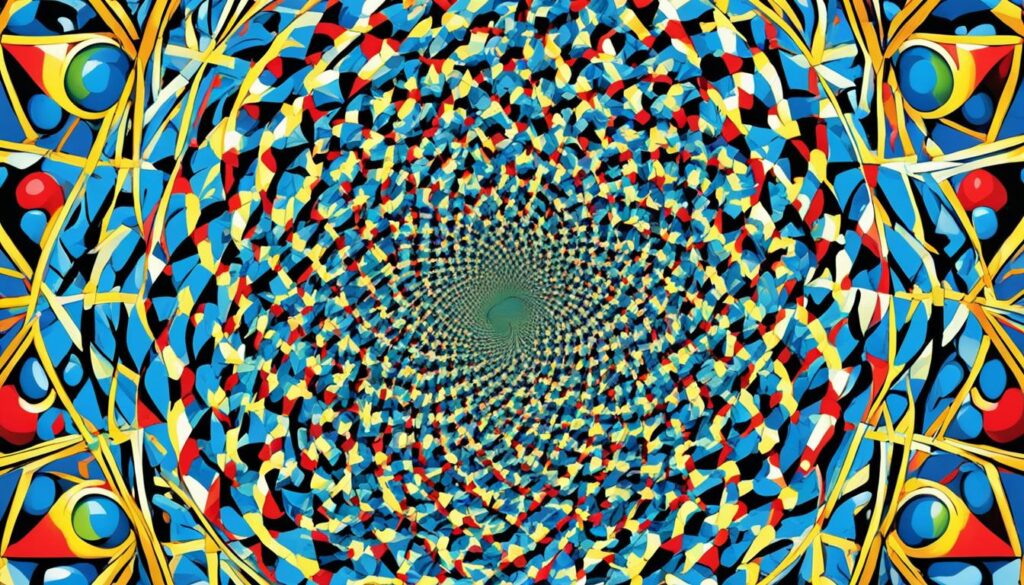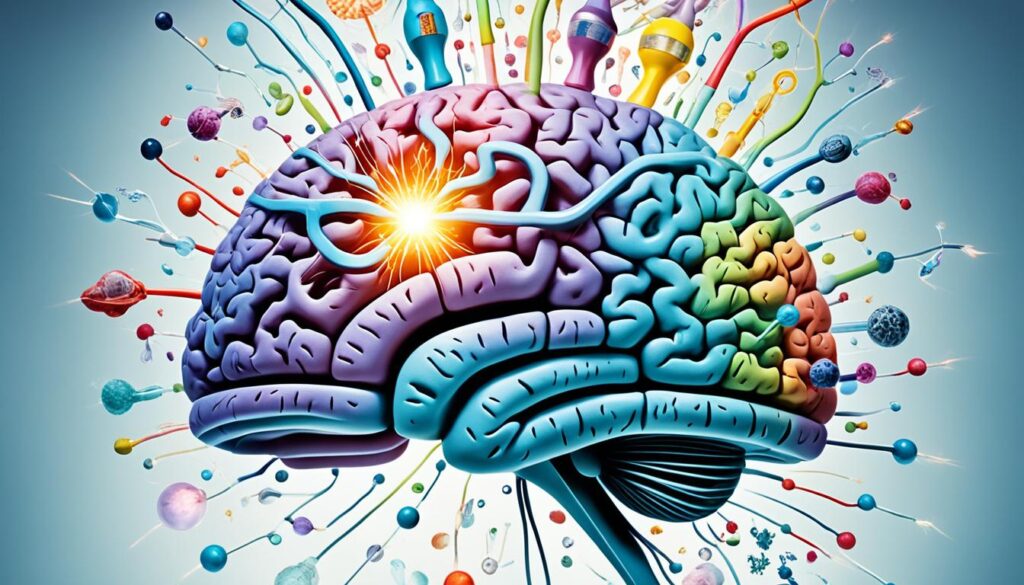Get ready to explore the amazing world of the human brain. We’ll look at its incredible abilities and strange features. The brain is truly a wonder of nature.
Did you know the human brain has over 100 billion neurons? Each one can connect with up to 10,000 others. This network lets our brains work super fast, making it a biological marvel.
The brain does more than just process information fast. It’s full of mysteries, like the mix of gray and white matter that helps us think. It can also change and adapt as we live.
Get ready for some weird facts about the brain. It plays a role in optical illusions and has a nightly show of dreams. We’ll look at the amygdala, the emotional center, and how it helps us feel.
Join us on this journey into the strange and amazing world of the human brain. Get ready to be amazed, entertained, and awestruck by this incredible organ.
Unusual Facts About the Incredible Human Brain
The human brain is a true marvel of nature, full of surprises. It’s amazing how much it can do. Let’s explore some surprising facts about this incredible organ.
Did you know the brain has no pain receptors? This means it can’t feel pain, even though it’s key for sensing the body. This is just one of the many brain wonders scientists are still learning about.
Another cool fact is that the brain can power a small light bulb with its electricity. It’s not enough for a whole room, but it shows how powerful the brain’s neural network is. It works super fast to process information.
Researchers found that the brain can change size based on our experiences and learning. This is called brain plasticity. It shows how the brain can adapt and change over our lives.
The human brain is full of surprises and mysteries. As we learn more about it, we’re always amazed by its complexity and abilities. It’s truly incredible what’s inside each of us.
The Brain’s Powerful Processing Capabilities
The human brain is a true marvel of nature. It has incredible parallel processing capabilities and can multitask effortlessly. It shows how this amazing organ handles many tasks at once with great efficiency.
Parallel Processing Powerhouse
Unlike computers that process one thing at a time, the brain works in parallel. This lets it look at and process many streams of information at once. It boosts its power to handle complex problems and make quick, accurate decisions.
Effortless Multitasking Marvel
The human brain’s ability to multitask is amazing. Even when we feel overwhelmed, the brain manages it well. It switches between tasks easily and uses resources as needed, making multitasking look easy.
This shows the brain’s incredible processing power and multitasking skills. Its ability to adapt and compute is truly remarkable. Learning how the brain works can satisfy our curiosity and lead to new discoveries in fields like artificial intelligence and cognitive neuroscience.
Mind-Bending Brain Anatomy
The human brain is an amazing organ. It has many structures that work together to shape our thoughts, feelings, and actions. At the heart of this complex system are gray matter and white matter. These two parts are key to the brain’s anatomy and how it works.
Gray Matter and White Matter: The Dynamic Duo
Gray matter is the dark, bumpy tissue on the brain’s outer layer, called the cerebral cortex. Most of the brain’s nerve cells are here, processing and combining information. White matter, on the other hand, is the stringy tissue deeper in the brain. It connects different areas and helps signals move quickly between them.
Gray matter handles the brain’s tasks like processing information and making decisions. White matter is like the brain’s expressway, making sure everything works together smoothly. These two parts work together to make the human brain so complex and versatile.
The mix of gray and white matter in the brain can change from person to person and over time. Things like age, education, and lifestyle can affect the brain’s structure. This shows how adaptable and flexible the brain is.
Brain Plasticity: The Ever-changing Landscape
The human brain is amazing in how it changes and adapts. It can change and reorganize itself, a process called brain plasticity. This lets the brain adjust and change its connections in response to new things we learn or experience.
Brain plasticity means the brain can change its structure and function over time. When we learn new things or face new challenges, our brain cells, or neurons, make new connections. This keeps the brain flexible and able to handle new situations.
Scientists have found that brain plasticity happens at all ages, from being young to old. Our brain can adapt to injuries, learn new tasks, and even create new paths for information to travel. This is key to how we learn, remember things, and think.
Knowing about brain plasticity is important for many areas, like education, rehab, mental health, and improving brain function. It helps us create better ways to help people overcome brain challenges and improve their thinking skills. This leads to better learning and personal growth throughout life.
The brain’s ability to change shows its amazing adaptability and strength. Seeing the brain as a dynamic system that can change helps us understand its power. It shows us how our brain can shape our lives and our potential.
Sleeping Brains: The Nocturnal Wonders
Even when we’re resting, our brains stay busy at night. They perform a nightly show of dreams that show us what’s inside our minds. Let’s explore the amazing world of sleep and the secrets of our dreaming brains.
Dream Decoding: The Brain’s Nightly Theater
Dreams have always fascinated us. They happen when our brains are active in sleep. By studying sleep, scientists are learning more about our brains and what they do at night.
During sleep, the brain’s activity is complex. The part that thinks logically gets quieter, but the emotional part gets louder. This change lets us have vivid dreams. By understanding this, scientists are learning more about dreams and the brain.
Exploring the sleeping brain helps us understand more about thinking and behavior. It shows how sleep affects memory and emotions. This research could greatly improve our knowledge of the human mind.
Optical Illusions and the Trickster Brain
Get ready to be amazed by the world of optical illusions and how our brains trick us. The human brain is a complex wonder, always trying to understand the world. Sometimes, it gets fooled by what we see.
Visual Perception Paradoxes
Optical illusions and visual paradoxes show us how our brains work. They reveal the complex processes that shape what we see. These tricks make us doubt our senses and question how we see the world.
The Muller-Lyer illusion makes two lines look different, even if they’re the same length. The Ponzo illusion makes objects look bigger if they’re higher on the page. These illusions show how our brains can play tricks on us.
By studying these illusions, scientists learn more about how we see things. This helps us understand the brain better. It also helps create new technologies that use how our brains work.

Exploring optical illusions and visual paradoxes shows us how smart our brains are. This amazing organ tries to make sense of everything. Sometimes, it creates tricks that challenge what we think is real.
The Brain’s Incredible Memory Capacity
The human brain is truly amazing, with an incredible ability to store and recall memories. It handles everything from quick flashes of short-term memory to deep long-term memories with ease.
From Short-term to Long-term: Memory’s Intricate Paths
Our brains are great at keeping and remembering information. First, it stores information in short-term memory for quick use. This lets us remember a phone number long enough to dial it or recall a recent chat.
Then, the brain turns these short-term thoughts into long-term memories. This process of memory formation lets us recall memories for years or even a lifetime. The brain memory system is amazing at storing and finding information, holding a huge amount of data.
Experts say the average brain can store about 2.5 petabytes of information. That’s like having 3 million DVDs worth of data. This means our brains can handle both short-term memory and long-term memory tasks, helping us live our daily lives, learn new things, and remember our past.
The brain’s memory systems are huge and can change. Through neuroplasticity, the brain can make new connections and paths for new info and experiences. This keeps our brains flexible and able to grow as we age.
Unusual Facts: The Brain’s Quirky Side
Get ready to be amazed and curious as we dive into the quirky side of the human brain. We’ll uncover unusual brain quirks and fun facts that show how unique and unexpected the brain can be.
Did you know the human brain has about 86 billion neurons? Each one can connect with thousands of others. This network makes the brain powerful but also leads to some interesting quirks. For example, our brains can see optical illusions and sometimes create false memories.
One fascinating quirk is synesthesia, where people mix senses. Some see numbers or letters in colors or tastes. This shows how the brain can create vivid experiences across different senses.
Another quirk is the “Tetris effect.” People who play the game might see falling shapes even when they’re not playing. This shows how the brain keeps processing information long after the game ends.
Exploring the brain’s quirks leads us to more fun facts that challenge what we know. The brain can change itself through neuroplasticity and has mysteries in the subconscious mind. The human brain is always full of surprises and discoveries.
Brain Myths and Misconceptions Debunked
The human brain is amazing and complex, but it’s filled with myths and misconceptions. Let’s explore brain science to find out what’s true about some common beliefs.
Many think we only use 10% of our brain. This is not true. The brain is always active, working together to handle information, control our body, and shape our thoughts and actions. We use all parts of our brain, not just a small part.

Some believe listening to classical music can make you smarter, known as the “Mozart effect.” While music might improve spatial-temporal reasoning for a short time, it doesn’t boost your IQ long-term. Music has many benefits, but it won’t make you a genius.
It’s a myth that the brain works like a muscle that can be “exercised” to get better. While we can improve specific skills through practice, brain exercises don’t boost intelligence or memory for everyone. The brain’s performance is shaped by genetics, age, and health.
It’s important to know the truth about the brain to separate fact from fiction. By understanding brain science, we can appreciate how amazing and complex our brains are.
The Emotional Brain: Navigating Feelings
The human brain is amazing, able to handle a complex mix of emotions. At its core is the amygdala, a small almond-shaped part that helps shape our feelings and actions. It acts like a guard, quickly sorting through sensory info and sparking the right emotional responses.
Amygdala: The Emotion Control Center
The amygdala is seen as the emotional “center” of the brain. It’s in charge of spotting, understanding, and acting on emotional signals. When something emotional happens, the amygdala jumps into action. It sets off the limbic system and starts changes in the body that get us ready to act.
This fast way of handling emotions helps us quickly deal with threats or chances, which is key for survival. But the amygdala does more than just spot fear and danger. It also helps us feel joy, anger, and disgust. By linking sensory info with memories and what we’ve learned, the amygdala guides us through the complex world of emotions. It affects how we make decisions, interact with others, and understand our feelings.






